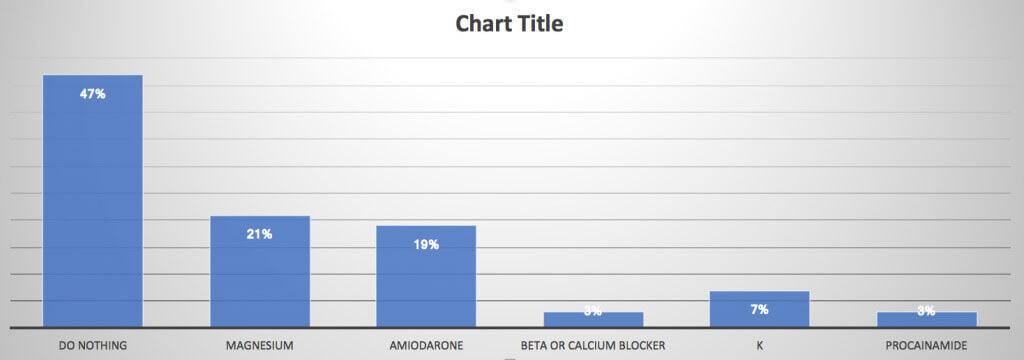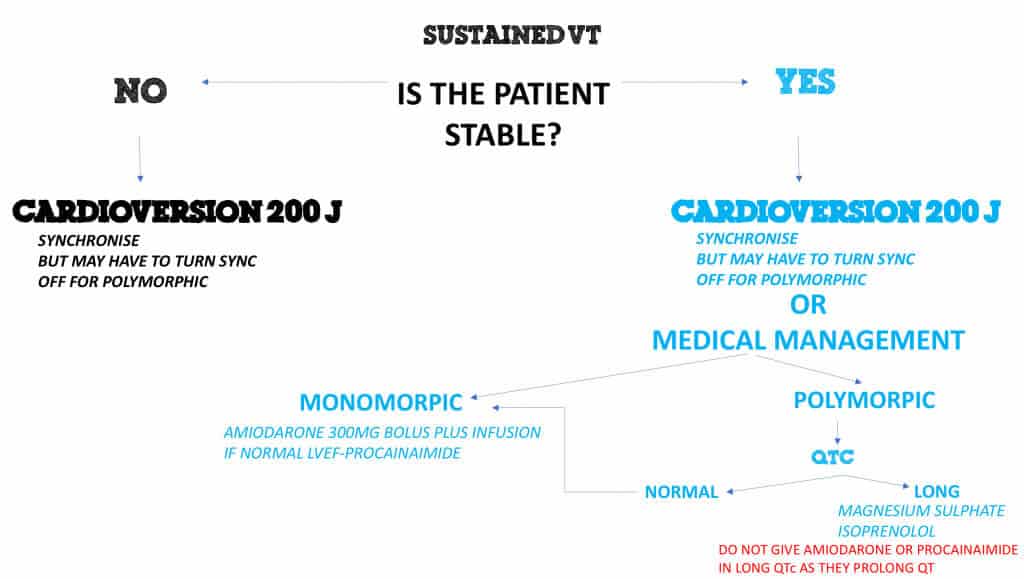A 74 year old man who has presented with seizure-like activity. He was not post ictal. Following this he had a cardiac arrest that was death with, with CPR and he quickly regained return of spontaneous circulation. He is now speaking and awake. His ECG is normal sinus rhythm, but you notice his rhythm strip when he first presented. It is a wide complex tachycardia presumed to be Ventricular Tachycardia, that has lasted for approximately 20 seconds. He has had no further episodes. Your working diagnosis is that the Ventricular Arrhythmia has caused the seizure-like activity.
According to my 3 rules for diagnosis VT, if all 3 are positive treat as VT:
- The QRS is wider than 120ms
- The rate is faster than 120
- It is real, ie., not artifact.
This therefore VT.
The question I ask is, what do we do? The options are:
- Do nothing
- Give Mg 10mmol/L
- Give Amiodarone
- Give Metoprolol or Ca channel blocker
- Give Potassium
- Give Procainamide
The recent survey results were very interesting. Approximately half of the group would do nothing in terms of treatment and about one fifth would give magnesium and one fifth would give amiodarone.

The literature is not clear cut on all of this, however clear enough that we know what to do.
In all cases we should ensure that electrolytes are normal. Therefore by all means top up the potassium and top up the Magnesium Sulphate. Here is an overview of both non-sustained and sustained VT.
NON-SUSTAINED VT(NSVT)
The definition of non-sustained VT varies in the literature. The rate varies from greater than 100 to greater than 120 beats per minute, the duration of the beats varies and even the total number of beats varies.
We don’t know the significance of NSVT in healthy individuals. In athletes they have no adverse prognosis. In non-athletes, they may represent a greater risk of death if they occur during exercise recovery, rather than during exercise.
The underlying heart conditions we must look for include:
- Coronary Artery Disease
- Cardiomyopathy
- Hypertension
- Channelopathies
- Valve Disease
An Approach To NSVT
Was this NSVT?
The definition we will use is a widely accepted one:
- Rate >120
- 3 or more consecutive beats
- Duration is < 30 seconds
Was the patient symptomatic?
Symptoms can include chest pain, palpitations, dyspnoea and syncope, or altered conscious state.
Does The Patient Have Underlying Heart Disease?
This may sometimes be difficult to know. It usually refers to a reduced Left Ventricular Ejection Fraction or Cardiac Failure.
If there are no symptoms and no heart disease, then no treatment is needed.
If the patient has no symptoms but does have underlying heart disease, and the NSVT is an incidental finding, ensure their treatment for their condition is appropriate and maximised.
- If the patient does have symptoms, ensure their medications are appropriate if they have heart disease and treat them whether heart disease or not with appropriate medication:
- This is usually Beta blockers or Ca channel blockers, in more of an outpatient setting
- Antiarrhythmics are used in the Emergency Department
- Amiodarone is very effective in suppressing VT
- It can be used in patients with underlying heart disease.
Below is the approach to the patient with NSVT

SUSTAINED VT
An Approach To The UNSTABLE Patient.
If the patient is unstable, which is judged by end organ involvement ie, chest pain, dyspnoea, haemodynamic compromise, then CARDIOVERSION can be used. Use 200J. Beware in polymorphic VT, as the defibrillator may have trouble picking up the R wave. In this case, turn sync off.
An Approach to the STABLE Patient
If the patient is stable CARDIOVERSION can still be used. If alternative medical treatment is considered, then its is a matter of what type of tachycardia it is.
Monomorphic Tachycardia.
If there is a normal Left Ventricular Ejection Fraction(LVEF), then Procainamide or Sotalol can be used
If there is an abnormal LVEF then Amiodarone should be used as Procainamide may exacerbate heart failure.
Polymorphic Tachycardia
Polymorphic tachycardia, normally self terminates, however it recurs. During one of the reversions to sinus rhythms and ECG must be done and the QTcorrected interval must be calculated.
If the QTcorrected is normal treat as for monomorphic VT
If the QTcorrected is prolonged, treat with Magnesium Sulphate and Isoprenelol.
BEWARE: Amiodarone and Procainamide are contraindicated in PROLONGED QTc, as they can further prolong the QT interval.
Below is the Approach to the Patient with Sustained VT

Conclusion
In our case study we had a patient with non-sustained ventricular tachycardia, who was symptomatic. The symptoms were the seizure-like activity, with no-post ictal component, Therefore, the seizure activity probably represented a response to the patient dropping their blood pressure. We have no idea of underlying heart disease in this case when the patient presented. The options in this patient were to start a beta blocker, however in the acute setting, Amiodarone is the appropriate drug to start.










Where did you find Procainamide in Australia?
Let us know so we can get some.
Hi Rahul
it is still available in Australia. We have it in our emergency department. You just have to ask your pharmacy to get it.
Peter
Non-Sustained Ventricular Tachycardia; What Would You Do? – Resus
[url=http://www.gj45c8xs33yu20d76622qeft2jg3t8c0s.org/]uoesyxosbpf[/url]
oesyxosbpf http://www.gj45c8xs33yu20d76622qeft2jg3t8c0s.org/
aoesyxosbpf
Authentic Fluke 561 Infrared Thermometer
Chauvet Led Par Lights
Aluminum Foil Epe Cooler Cooler Bag
Heya i am for the first time here. I came across this board and I find It really useful
Industrial Power Connector
I’ve been surfing online more than 3 hours today, but I never discovered any attention-grabbing article like yours. It¡¦s pretty worth enough for me. In my view, if all web owners and bloggers made good content material as you did, the internet can be much more useful than ever before.
Wow, fantastic blog layout! How long have you been blogging for? you make blogging look easy. The overall look of your site is magnificent, as well as the content!
3 Piece Steamer Pot
韓国スーパーコピー没収スーパーコピー財布ランク
Online Monitoring Of Ammonia
ロレックススーパーコピー激安販売
best portable toilet for campervan
ロレックスコピー時計代引き
Chanelシャネルマフラースーパーコピー
water saving restroom
Reishi Extra Capsule
LouisVuittonルイヴィトン財布スーパーコピー
Glass Stone Kitchen
Chanelシャネル時計スーパーコピー
Gucciグッチマフラースーパーコピー
Herbal Medicine For Animal Kidneys
Fantastic goods from you, man. I’ve understand your stuff previous to and you are just extremely fantastic. I really like what you have acquired here, really like what you are stating and the way in which you say it. You make it entertaining and you still take care of to keep it sensible. I can’t wait to read far more from you. This is really a tremendous site.
Wow that was strange. I just wrote an incredibly long
comment but after I clicked submit my comment didn’t appear.
Grrrr… well I’m not writing all that over again. Anyhow,
just wanted to say fantastic blog!
Custom Squeeze Bottle
ブランドGoyardゴヤール財布コピーN級品
StellaMccartneyステラマッカートニーコピー激安
Black Hi Vis Hoodie
Excavator
ブランドFendiフェンディベルトコピー代引き
MCMエムシーエム財布スーパーコピー
China Tongkat Ali Powder Organic
LouisVuittonルイヴィトンサングラスコピー
Polyethylene Rope
1 Row Cultivator
Chanelシャネルマフラーコピー
スーパーコピーバッグ
Wheel Loader Bucket Teeth
Cast Iron Casserole Pan
ブランドHermesエルメス靴コピーN級品
I have been surfing online more than 3 hours today, yet I never found any interesting article like yours. It is pretty worth enough for me. In my opinion, if all web owners and bloggers made good content as you did, the internet will be much more useful than ever before.
ブランドバッグコピー
Electrical Equipment Lockout
ブランドコピー代引き
Galfan Galvanized Gabion
Bfl913 Engine Alternator
スーパーコピーブランド
ブランドコピー代引き
Cattle Heat Detector
I think other site proprietors should take this website as an model, very clean and great user genial style and design, let alone the content. You’re an expert in this topic!
Great tremendous things here. I’m very glad to look your article. Thank you so much and i am taking a look ahead to contact you. Will you please drop me a mail?
Acacia Wood Serving Board
ブランドコピー専門店
I’m extremely impressed with your writing skills as well as with the layout on your weblog. Is this a paid theme or did you customize it yourself? Anyway keep up the excellent quality writing, it’s rare to see a great blog like this one nowadays..
Keep functioning ,remarkable job!
コピー時計
Buy Key Lock Box
Burberryバーバリーバッグスーパーコピー
Heavy Duty Pallet Rack
Profile Roll Forming Machine
MiuMiuミュウミュウバッグコピー
Burberryバーバリー帽子コピー
Q-Switched Laser
10g Ozone Generator
BottegaVenetaボッテガヴェネタベルト販売店
Non Stick Sheet Pan
スーパーコピーバッグ
Hello there, just became alert to your blog through Google, and found that it is truly informative. I am gonna watch out for brussels. I’ll be grateful if you continue this in future. Lots of people will be benefited from your writing. Cheers!
There is noticeably a lot to realize about this. I consider you made some good points in features also.
Nice post. I was checking constantly this blog and I am impressed! Very useful info specifically the last part 🙂 I care for such info a lot. I was looking for this particular info for a long time. Thank you and good luck.
1.25 Silicone Hose
Hermesエルメスイヤリング販売店
high end porta potty
ブランドPaneraiパネライ時計コピーN級品
Pelletizer Machine
ブランドLouisVuittonルイヴィトン財布コピー代引き
I’ve been surfing online more than 3 hours today, but I never discovered any attention-grabbing article like yours. It¡¦s pretty worth enough for me. In my view, if all web owners and bloggers made good content material as you did, the internet can be much more useful than ever before.
Drip Pipe With Round Emitter
ブランド時計コピー
ブランドMCMエムシーエム財布コピー代引き
squat type toilet bowl
1440p 120hz Hdr Monitor
Diorディオールマフラーコピー
Glass Fiber Surfacing Mat
AudemarsPiguetオーデマピゲスーパーコピー
Oxide Powder Color
Breitlingブライトリングバッグコピー
Pattern Roller Blinds Fabric
ブランドOmegaオメガ時計コピーN級品
You are a very clever person!
Gucciグッチマフラーコピー
Metal Saw Factory
Well I sincerely liked studying it. This tip offered by you is very helpful for good planning.
Its like you read my mind! You appear to know a lot about this, like you wrote the book in it or something. I think that you can do with some pics to drive the message home a bit, but instead of that, this is wonderful blog. A great read. I’ll definitely be back.
Body Fat Analyzer Accuracy
Goyardゴヤール財布スーパーコピー
コピー時計
Flex Ccl
ブランド財布コピー
HVAC Pre-Insulated Air Duct Panel
ブランドコピー代引き
HT-460 co2 laser engraving and cutting machine
Normally I do not learn post on blogs, however I wish to say that this write-up very forced me to take a look at and do so! Your writing style has been amazed me. Thanks, quite great article.
Vw Dpf Sensor
Narrow Pore Silica Gel??A Type Silica Gel)
コピー時計
51396-TEA-T10
Antique Carring Coffee Table Sets
ブランドコピー専門店